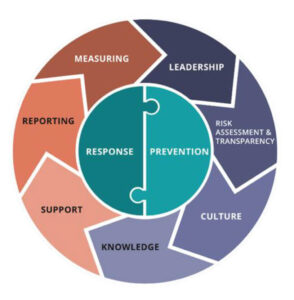Your cart is empty.


Your cart is empty.
This material is designed and intended to provide general information in summary form on legal topics, current at the time of publication, for general informational purposes only. This is not legal advice.
On 5 March 2020 the Sex Discrimination Commissioner, Kate Jenkins, released a report called ‘Respect@Work: Sexual Harassment National Inquiry Report’, in which the Commissioner made 55 Recommendations for the elimination of workplace sexual harassment.
The Anti-Discrimination and Human Rights Legislation (Respect@Work) Bill passed Parliament and received Royal Assent on 12 December 2022. It implemented the remaining Recommendations of the Respect@Work report.
Effective from 13th December 2022, employers have a legislated positive obligation to take reasonable and proportionate measures to eliminate sex discrimination, sexual harassment and victimisation, as far as possible.
The significance of this amendment in terms of liability, is that an employer is now not only vicariously liable under the Sex Discrimination Act 1984 for Sexual Harassment in the workplace, but they now also have a positive obligation to be proactive and take preventative action to stop sexual harassment from occurring in the workplace.
Your obligation as an employer is to ensure the health and safety of your workers. A workplace is a dynamic place where people with different life experiences, different levels of power and responsibilities interact to create what is acceptable and unacceptable behaviour in that space. Because of this, all workplaces need to be continually and actively reviewing and ensuring that the space they are creating is safe and inclusive.

Image courtesy of AHRC.
There are various actions an employer can take to ensure they are meeting their positive duty.
The government has made it clear with these legislative amendments that Australia has a no tolerance policy to sexual harassment in the workplace. This attitude is reflected in the cultural change we have seen in the media and wider communities.
As of 13th December 2022, a person conducting a business or undertaking (PCBU) is exposing themselves to risk of legal action by failing to take preventative measures to prevent sexual harassment. If sexual harassment happens in connection with one of your employees, then you could be faced with one or more of the following outcomes:
As a part of an employer’s positive obligation to prevent sexual harassment, the organisation or business should proactively educate leaders, and other staff members in management, on the recent law reform and new obligations.
Powers of Australian Human Rights Commission
From 13 December 2023, the Australian Human Rights Commission will have regulatory powers to monitor and enforce compliance of this positive duty. These powers include conducting inquiries and applying to the federal courts for orders to be made against businesses.
To protect your workers, lower your liability of legal risk, and protect the reputation of your business, it is essential that you inform yourself of this positive obligation and what is required of you to satisfy this obligation.
The Working Womens Centre SA offers free and fee for service training for workplaces to educate them on their legal obligations under workplace and discrimination legislation. Our goal is to provide workplaces with the practical tools to support their staff through training, policy development and ongoing consultation.
Training Package – Preventing and Addressing Sexual Harassment
This training is for organisations and businesses to increase knowledge of what sexual harassment in the workplace is according to current legislation, including recent amendments that put a positive obligation on employers to prevent sexual harassment.
Employers will learn practical strategies to prevent sexual harassment at work, dealing with sexual harassment and discrimination complaints, and learn how to create a positive workplace culture free from inappropriate behaviours.
We work with you to tailor our packages to suit your specific context/industry and can tailor training for different people with varying responsibilities within your organisation.
This training package covers the following:
For any enquiries or to book a training session today, contact our office of 8410 6499, make an online enquiry, or email us at training@wwc.org.au.